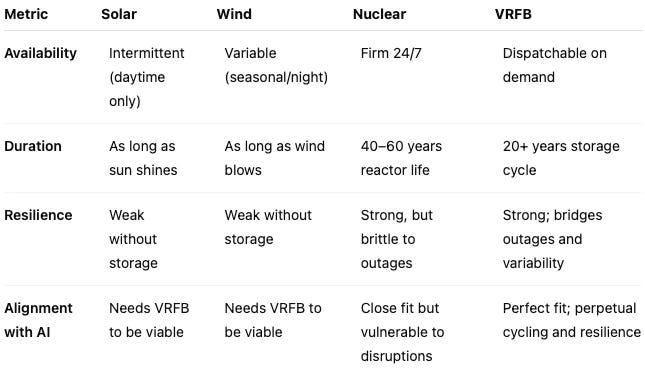MCAI Market Vision: VRFB’s Role in AI Energy Infrastructure
Perpetual Energy for Perpetual Intelligence — Aligning Infrastructure Permanence with the Age of AI
See also companion study MCAI Market Vision: The Bottleneck Hierarchy in U.S. AI Data Centers, Predictive Cognitive AI and Data Center Energy, Networking, Cooling Constraints (Aug 2025), Nvidia's Moat vs. AI Datacenter Infrastructure-Customized Competitors (Aug 2025), AI Datacenter Edge Computing, Ship the Workload Not the Power (Sep 2025).
Executive Summary
Artificial intelligence workloads are expanding faster than the grid can adapt. Training and inference systems demand not only vast amounts of power but also resilience, predictability, and permanence. Traditional energy sources—solar, wind, nuclear—each provide value but carry limitations. Legacy options like diesel generators, lithium-ion batteries, and hydrogen fuel cells fill gaps but fall short on permanence, safety, or cost stability.
Vanadium Redox Flow Batteries (VRFBs) offer a different paradigm. They do not generate energy themselves, but they redefine how energy can be stored and delivered to align with AI’s “perpetual demand curve.” VRFBs enhance renewables, supplement nuclear, and outperform legacy storage options. For hyperscale AI, they represent the only energy storage technology capable of matching the 20+ year infrastructure horizons of intelligence systems. In foresight terms, VRFBs are the energy permanence layer that enables uninterrupted scaling of next-generation AI clusters. Or as the vision states: “Perpetual intelligence requires perpetual energy.”
Contact mcai@mindcast-com to partner with us on predictive cognitive AI and foresight simulations.
I. VRFB’s Role vs. Generation Sources
AI’s growth forces data centers to confront the mismatch between intermittent supply and perpetual demand. Solar and wind are abundant but unreliable; nuclear is firm but not immune to disruption. VRFBs act as the connective tissue, transforming variable or brittle generation into dependable power flows. Their value lies in converting abundance into permanence—what can be described as the resilience dividend of perpetual infrastructure.
Solar & Wind
Solar and wind power are abundant and renewable but fundamentally intermittent. AI clusters cannot tolerate fluctuations: training jobs stretch across weeks, inference runs 24/7, and downtime translates to catastrophic costs. VRFBs convert intermittent supply into dispatchable power:
Day-night smoothing: Store solar output by day, release at night.
Weather variability: Absorb oversupply during windy nights, deliver during calm periods.
Deep cycling: Handle 100% depth-of-discharge daily without degradation, unlike lithium-ion.
Without VRFB, solar and wind remain fragile for hyperscale AI. With VRFB, they become credible cornerstones of perpetual intelligence infrastructure.
Nuclear
Nuclear is the closest natural ally for AI data centers: firm, carbon-free, and long-lived. But nuclear plants are brittle when grids fail or transmission bottlenecks appear. VRFBs add:
Local resilience: Redundancy at the facility level.
Transient smoothing: Covering millisecond-to-hour gaps from reactor trips or grid instability.
Complementary permanence: Extending resilience beyond the already long planning horizons of nuclear.
Nuclear sets the baseline; VRFB ensures continuity when even the most reliable baseload falters.
Strategic Result
VRFB does not compete with renewables or nuclear—it amplifies them. The storage layer aligns fragile or intermittent generation with AI’s demand curve. In foresight terms: VRFB is the keystone that converts energy abundance into energy permanence.
The conclusion is clear: solar and wind need VRFB to serve AI workloads reliably, and even nuclear benefits from its resilience. By filling gaps across different energy sources, VRFB ensures continuity in ways no other storage can. The result is a foundation of permanence that aligns with intelligence horizons and sustains trillion-parameter model training into the 2040s.
II. VRFB’s Role vs. Other Energy Options
Energy permanence cannot be achieved by legacy backup systems alone. Diesel generators, lithium-ion batteries, and hydrogen fuel cells each address fragments of the reliability problem but carry structural weaknesses. VRFBs outperform these incumbents on longevity, safety, cost stability, and alignment with perpetual demand. Their maturity makes them the decisive differentiator in an era where infrastructure sovereignty matters as much as compute sovereignty.
Diesel Generators
Diesel remains the default backup for most data centers. Its flaws are stark:
High emissions and community opposition.
Short lifespans and high maintenance.
Misalignment with decarbonization policies.
VRFBs deliver cleaner, longer-lasting resilience, providing competitive and reputational advantages.
Lithium-Ion Batteries
Li-ion is optimized for devices and EVs, not perpetual AI clusters.
Longevity: 5–7 years vs. VRFB’s 20+.
Cycling: Li-ion degrades under 100% daily cycling; VRFB thrives.
Safety: Li-ion is prone to thermal runaway; VRFB is non-flammable.
VRFB decisively outperforms on every metric relevant to hyperscale AI.
Hydrogen Fuel Cells
Hydrogen attracts attention as a green alternative, but:
Cost: Production and logistics remain expensive.
Maturity: Supply chains and infrastructure are nascent.
Stability: Storage and transport are politically and technically contested.
VRFBs, by contrast, are commercially mature and stable, offering predictable economics.
Compared to diesel, lithium-ion, and hydrogen, VRFBs emerge as the only storage solution that balances permanence, safety, and cost-effectiveness. They move beyond stopgap fixes and align directly with hyperscale AI’s requirements. Looking ahead, they unlock the reliability needed for autonomous research ecosystems and continuous-scale inference services. As Gary Yang put it: “Lithium-ion was for devices. Vanadium flow is for civilization.”
III. Comparative Matrix
A structured comparison clarifies how VRFBs measure up against major generation sources. Solar, wind, and nuclear provide electrons but lack permanence on their own; VRFB bridges these gaps. The matrix below captures availability, duration, resilience, and AI alignment across options.
The matrix shows how VRFB stands apart as the enabler of energy permanence. It is not generation but makes generation viable for perpetual intelligence. By enhancing renewables and reinforcing nuclear, VRFB aligns energy supply with AI’s unbroken demand. Looking forward, this alignment makes possible uninterrupted scaling of AI clusters that will design medicines, power smart cities, and fuel the discovery engines of the 2030s and beyond.




